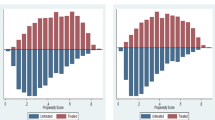Abstract
The main difficulty in treatment effect analysis with matching is accounting for unobserved differences (i.e., selection problem) between the treatment and control groups, because matching assumes no such differences. The traditional way to tackle the difficulty has been “control function” approaches with selection correction terms. This paper examines relatively new approaches: sensitivity analyses—sensitivity to unobservables—in Rosenbaum (Biometrika 74:13–26, 1987), Gastwirth et al. (Biometrika 85:907–920, 1998) and Lee (J Appl Econ 19:323–337, 2004). These sensitivity analyses are applied to the data used in Lee and Lee (J Appl Econ 20:549–562, 2005) to see how the assumption of no unobserved difference in matching affects the findings in Lee and Lee, to compare how the different sensitivity analyses perform, and to relate the “sensitivity parameters” in the different sensitivity analyses to one another. We find (i) the conclusions in Lee and Lee are weakened in the sense that only the “strong” ones survive, (ii) the sensitivity analysis in Rosenbaum (Biometrika 74:13–26, 1987) is too conservative (and inferior to Gastwirth et al.’s), and (iii) Gastwirth et al.’s and Lee’s approaches agree on some findings to be insensitive, but the two approaches also disagree on some other findings.
Similar content being viewed by others
References
Aakvik A (2001) Bounding a matching estimator: the case of a Norwegian training program. Oxf Bull Econ Stat 63: 115–143
Altonji JG, Elder TE, Taber CR (2005) Selection on observed and unobserved variables: assessing the effectiveness of Catholic schools. J Pol Econ 113: 151–184
Angrist JD, Krueger AB (1999) Empirical strategies in labor economics. In: Ashenfelter OC, Card D (eds) Handbook of labor economics 3A. North-Holland, Amsterdam
Caliendo M, Hujer R, Thomsen SL (2005) The employment effects of job creation schemes in Germany: a microeconometric evaluation. IZA Discussion Paper 1512
Gastwirth JL, Krieger AM, Rosenbaum PR (1998) Dual and simultaneous sensitivity analysis for matched pairs. Biometrika 85: 907–920
Heckman JJ, Ichimura H, Smith J, Todd P (1998) Characterizing selection bias using experimental data. Econometrica 66: 1017–1098
Heckman JJ, Lalonde RJ, Smith JA (1999) The economics and econometrics of active labor market programs. In: Ashenfelter OC, Card D (eds) Handbook of labor economics 3B. North-Holland, Amsterdam
Heckman JJ, Tobias JL, Vytlacil E (2003) Simple estimators for treatment parameters in a latent-variable framework. Rev Econ Stat 85: 748–755
Hujer R, Caliendo M, Thomsen SL (2004) New evidence on the effects of job creation scheme in Germany—a matching approach with threefold heterogeneity. Res Econ 58: 257–302
Hujer R, Thomsen SL (2006) How do employment effects of job creation schemes differ with respect to the foregoing unemployment duration. ZEW Discussion Paper 06–47
Ichino A, Mealli F, Nannicini T (2008) From temporary help jobs to permanent employment: what can we learn from matching estimators and their sensitivity. J Appl Econ (forthcoming)
Imbens GW (2003) Sensitivity to exogeneity assumptions in program evaluation. Am Econ Rev (Papers and Proceedings) 93: 126–132
Imbens GW, Rosenbaum PR (2005) Robust, accurate confidence intervals with a weak instrument:quarter of birth and education. J R Stat Soc (Series A) 168: 109–126
Lee MJ (2004) Selection correction and sensitivity analysis for ordered treatment effect on count response. J Appl Econ 19: 323–337
Lee MJ (2005) Micro-econometrics for policy, program, and treatment effects. Oxford University Press, Oxford
Lee MJ, Lee SJ (2005) Analysis of job-training effects on Korean women. J Appl Econ 20: 549–562
Manski CF (2003) Partial identification of probability distributions. Springer, New York
Rosenbaum PR (1987) Sensitivity analysis for certain permutation inferences in matched observational studies. Biometrika 74: 13–26
Rosenbaum PR (2002) Observational studies, 2nd edn. Springer, New York
Rosenbaum PR, Rubin DB (1983a) The central role of the propensity score in observational studies for causal effects. Biometrika 70: 41–55
Rosenbaum PR, Rubin DB (1983b) Assessing sensitivity to an unobserved binary covariate in an observational study with binary outcome. J R Stat Soc (Series B) 45: 212–218
Rubin DB (1974) Estimating causal effects of treatments in randomized and nonrandomized studies. J Educ Psychol 66: 688–701
Author information
Authors and Affiliations
Corresponding author
Additional information
The authors are grateful to the Editor and anonymous reviewers for their constructive and helpful comments.
Rights and permissions
About this article
Cite this article
Lee, M.J., Lee, S.J. Sensitivity analysis of job-training effects on reemployment for Korean women. Empir Econ 36, 81–107 (2009). https://doi.org/10.1007/s00181-008-0188-z
Received:
Accepted:
Published:
Issue Date:
DOI: https://doi.org/10.1007/s00181-008-0188-z




